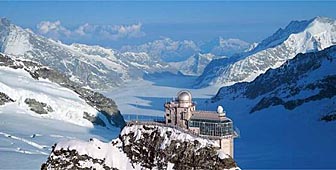A day’s work on the top of Europe

For many tourists, a trip to the Jungfraujoch - the highest railway station in Europe - is a once in a lifetime experience. But for a handful of people, it's simply part of their daily commute to work.
It’s a long day for Andreas Signer. She has to leave her home in Interlaken two and a half hours before she begins her eight-hour shift. Even though she only has to travel about 30 kilometres, she has to cover a difference in altitude of nearly 3,000 metres.
Signer is the station and postmaster of the Jungfraujoch railway station – 3,454 metres above sea level. Nobody issues tickets or stamps from a higher point in Europe. And she’s the only Swiss stationmaster who has altitude sickness tablets to hand out.
The final stage of the journey up to the Jungfraujoch starts on the Kleine Scheidegg plateau. A ticket for the short nine-kilometre stretch costs SFr100 ($62) – almost as much as a ticket for the main Geneva to Zurich line, which is 280 kilometres longer.
Most foreign tourists are willing to fork out that kind of money for the unique experience and breathtaking views of the Alps and glaciers.
Many Swiss tourists wait for special deals for the chance to breathe in the rarefied air. One of the Jungfrau Railway conductors, Frank Vogelin, had the misfortune of spending his first day on the job last summer trying to beat back crowds of Swiss – all in possession of a half price ticket handed out by their bank.
“We normally handle up to 5,000 people on a busy summer day,” remembers Vogelin. “But there were 15 of us trying to control 12,000 people on that day.
“When the train pulled into the Kleine Scheidegg station, everyone just jumped in or tried to open the doors with their Swiss army knives. They were pushing and shoving and climbing in through the windows. The carriages were so overloaded that the train couldn’t leave the station.”
To reach the Jungfraujoch, the train climbs slowly through a seven kilometre-long tunnel, dug into the sides of the Eiger and Mönch at the turn of the 20th century.
The train stops twice inside the tunnel, allowing passengers a few minutes to press their noses against the glass of panorama windows looking out onto the Eiger North Face and the glaciers known as the “Sea of Ice”. Tourists can’t resist taking pictures, even when falling snow turns the view into a blank white screen.
Once at the top, they’re reminded to walk slowly because of the thin air. But most can’t wait to get outside to plant their feet firmly on the “Top of Europe”, as the Jungfraujoch is known.
One vantage point is reached through an ice cavern, called the Ice Palace. It’s home to ice sculptures of Eskimos, seals and husky dogs, and even a larger-than-life Sumo wrestler.
It’s also where Toni Bravand spends his working day carving out a new exit with his ice pick. When he’s finished, the passage will lead into a lift that will whisk people quickly back to the railway station.
A technical supervisor, René Krebs, monitors the amount of available water stored in the Jungfraujoch tanks. Up to 5,000 litres are used every day. Half is transported up from the Kleine Scheidegg and the other half obtained from melted snow and ice from the roofs.
“We use up to 20,000 litres a day during the summer high season,” says Krebs. “All the visitors use the toilets and wash their hands. And the restaurant kitchens need a lot more water then as well.”
Over an average year, tourists produce about nine million litres of waste water. “We can’t simply pump it out onto a glacier,” Krebs continues. “It’s collected in a large sewage tank where it’s heated up to 25 degrees, and when the tank is full, we use high pressure pumps to send it down to the Kleine Scheidegg.
“We heat it up so it doesn’t freeze during the nine kilometre journey.” The whole trip, through pipes laid beside the railway tracks, takes only 12 minutes – only a fraction of the time it takes unaware passengers to return to the plateau after a day on the top of Europe.
by Dale Bechtel

In compliance with the JTI standards
More: SWI swissinfo.ch certified by the Journalism Trust Initiative

You can find an overview of ongoing debates with our journalists here. Please join us!
If you want to start a conversation about a topic raised in this article or want to report factual errors, email us at english@swissinfo.ch.